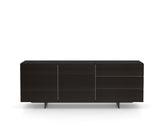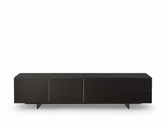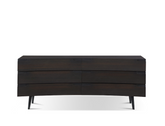Scandinavian Style for Singapore Homes

Scandinavian interior design has seen a surge in popularity in Singapore, and it’s no surprise why. This much-loved design style is centered on simplicity, functionality, and minimalism while infusing spaces with warmth and comfort. For those who appreciate clean, functional spaces, the Scandinavian design aesthetic is ideal.
From the use of natural materials to embracing the Danish concept of "hygge," Scandinavian design offers plenty to elevate your home. Whether you're renovating an HDB flat, a BTO apartment, or just want to add a few Nordic touches to your space, this comprehensive guide will provide everything you need to know.
What Is Scandinavian Interior Design?
Scandinavian interior design originated in the Nordic countries—Denmark, Sweden, Norway, Finland, and Iceland. Its primary focus is on minimalism, functionality, and simplicity while incorporating natural materials and cosy elements to create a warm and welcoming atmosphere.
The design style emphasizes functionality and practicality. Rather than just being decorative, every piece serves a purpose. Clean lines, neutral colours, and natural textures such as wood and stone are core elements of Scandinavian interiors. This minimalistic approach promotes a clutter-free space, which aligns well with Singapore’s modern, space-conscious homes like HDBs and BTO flats.
Another significant aspect of Scandinavian design is the concept of "hygge," a Danish term that embodies cosiness and contentment. This is achieved by adding soft lighting, warm textiles, and comfortable seating to create a peaceful retreat.
One of the defining features of this design style is the use of natural materials such as wood, leather, and wool. These materials help in crafting a serene atmosphere while also contributing to sustainability, an increasingly important consideration in Singapore’s eco-conscious urban living.
The History of Scandinavian Interior Design
If you've shopped for furniture at IKEA or other similar stores, you're already somewhat familiar with Scandinavian design. However, the origins of this popular style date back much further, emerging in the early 20th century in response to social and political shifts in the Nordic region.
In the early 1900s, Scandinavia experienced significant social changes that affected the art and design scene. The rise of socialism and the increasing importance of the welfare state led to a renewed focus on practicality, functionality, and accessibility in design. This shift resulted in a departure from the overly ornate interior styles of the past and a move toward simplicity and usability.
One of the pioneers of Scandinavian design was Finnish architect and designer Alvar Aalto. He championed the idea that design should serve a social purpose, not just an aesthetic one. Aalto’s work focused on natural materials and simple, clean lines, principles that remain integral to Scandinavian interiors today.
Danish designer Arne Jacobsen also played a key role in shaping Scandinavian design. His work was minimalist and functional, focusing on what was essential rather than embellishing unnecessarily.
In the 1950s and 60s, Scandinavian design gained global popularity, largely due to the success of furniture brands like IKEA, which brought affordable, functional, and stylish pieces to the masses. Today, the timeless nature of Scandinavian design continues to influence homes around the world, including in Singapore, where furniture stores like Prestige Affairs Furniture offer affordable Scandinavian-inspired pieces.
Key Elements of Scandinavian Interior Design
Several key features set Scandinavian design apart from other interior styles. These elements create a space that is both functional and aesthetically pleasing, making it a perfect fit for modern Singapore homes.
Light and Bright Colour Palettes
Scandinavian interiors are characterized by light, airy colour schemes. White, grey, beige, and other neutral tones dominate the palette, creating an open and spacious feeling. This approach works particularly well in smaller homes, making the space feel larger and more inviting.
Natural Materials
Natural materials such as wood, stone, leather, and wool are cornerstones of Scandinavian design. These elements introduce warmth and texture while creating a connection to nature. In a modern Singaporean setting, wooden floors, stone countertops, and woollen rugs can help transform an HDB or BTO into a Scandinavian haven.
Clean Lines
Scandinavian design is known for its clean, simple lines. This uncluttered approach creates a calm and orderly space, a feature that's particularly important in compact homes. Furniture is sleek and functional, often with hidden storage to maintain the minimalist look.
Minimalism
Minimalism is central to Scandinavian interior design. Rather than filling spaces with unnecessary items, the focus is on what is truly essential. This philosophy aligns with the growing trend of decluttering and simplifying living spaces, making it ideal for small HDB flats in Singapore.
Functional Furniture
Every piece of furniture in a Scandinavian home has a purpose. This often includes multi-functional furniture, such as storage beds, modular sofas, or extendable dining tables. These smart solutions maximize the usability of every room without sacrificing style.
Cosiness (Hygge)
Despite its minimalist approach, Scandinavian design doesn't shy away from creating a cosy atmosphere. Soft lighting, warm textiles like blankets, and plush seating areas help achieve a sense of "hygge" or cosiness, a concept that’s perfect for making homes feel inviting and restful.
Scandinavian Interior Design Tips for Your Home
If you're looking to bring Scandinavian design to your Singapore home, here are some practical ideas to get you started:
Maintain Uncluttered Spaces
One of the most important aspects of Scandinavian design is keeping clutter at bay. Invest in practical storage solutions to keep your home tidy and ensure surfaces are free of unnecessary items.
Opt for Neutral Colours
Stick to neutral tones such as whites, greys, and light woods. These colours create a serene environment that promotes relaxation, which is crucial in Singapore's fast-paced city life.
Maximise Natural Light
Light is key in Scandinavian interiors. Allow as much natural light into your home as possible. Opt for sheer curtains or no curtains at all to let in more sunlight.
Incorporate Wooden Accents
Natural materials like wood are central to Scandinavian design. Wooden coffee tables, bookshelves, or dining chairs can introduce warmth and texture to your space.
Choose Functional Furniture
In line with the minimalist ethos of Scandinavian design, choose furniture that serves a purpose. In a Scandinavian-style living room, a simple sofa paired with a functional coffee table can create a relaxing yet practical space.
Add Hygge Elements
Create a warm, inviting atmosphere with soft furnishings like blankets, pillows, and candles. These elements contribute to a cosier environment without overwhelming the minimalist design.
Scandinavian Interior Design FAQs
1. What defines Scandinavian interior design?
Scandinavian interior design focuses on minimalism, functionality, and the use of natural materials. Its hallmarks are clean lines, neutral colour palettes, and cosy touches that create a serene and inviting atmosphere.
2. What are common Scandinavian design materials?
Scandinavian design often uses natural materials like wood, leather, wool, and stone. These materials bring warmth and texture to the space while also contributing to sustainability.
3. How do I make my home feel more Scandinavian?
To achieve a Scandinavian-inspired home, focus on decluttering, using neutral tones, incorporating natural materials, and choosing functional furniture. Adding soft lighting and cosy textiles will complete the look.
Conclusion: Achieving Scandinavian Elegance in Your Home
Scandinavian interior design is an ideal choice for Singapore homes due to its emphasis on simplicity, functionality, and cosiness. By incorporating natural materials, decluttering your space, and focusing on functional furniture, you can create a stylish and comfortable home that feels both modern and timeless.
From HDB flats to BTO spaces, Scandinavian design principles can transform any living area into a peaceful, inviting sanctuary. Whether you're renovating or just refreshing your home’s look, this minimalist yet cosy design style offers endless possibilities.







